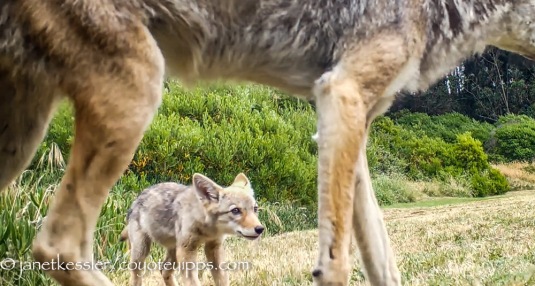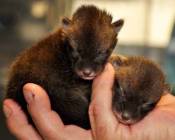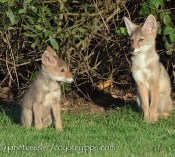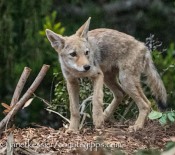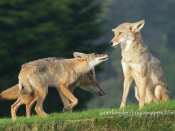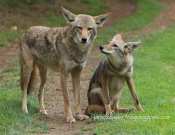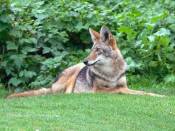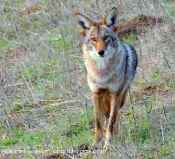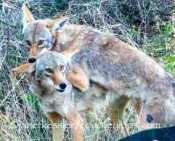
Well, “running away from home” isn’t exactly what happened (which is why I have the title in quotes), but watching a tiny kitten-size pup the other morning trekking decidedly away from his home inspired the idea. For a fun twist, I put together the above collage, and have written this posting sprinkled with that thought.
The morning began with a coyote dad bringing in a mouthful of animal-prey to his denning area. It was too far off and I wasn’t quick enough to see what they prey was, but it was the size of a large duck. He disappeared into the brush, and I hoped I would see him again. Within a very short time, I heard a coyote calling to another — I wasn’t given enough lead time to record it, it was not a sound I hear often: a short, warbled sound.
I looked up to where the sound came from and saw him standing and apparently waiting close to where I had seen him disappear earlier. He had been calling to his mate, because within a minute, she joined him. As they headed off, one and then two of their pups attempted tagging along. They either were told *no* or knew they wouldn’t be able to keep up because they immediately turned back. Youngsters desperately want to be with their parents, but no means no, and they were left in the safety of their den area. That was all I saw of the parents that morning.
One pup of this litter is a runt. I’ve observed runts before. They often don’t play with litter mates because their size makes it not fun for them: who likes to be beat up all the time? So they frequently play by themselves. And they go off by themselves. I’ve also seen runts given special attention by their parents: the extra nurturing probably helps their survival. Mom was there today most likely to nurse them, and I saw Dad bring in solid food as I stated above. I wondered if the runt might have been unable to get his share of milk or of what was brought in by Dad? I thought of these things immediately after what I saw next.






Leaving the den took several tries, each ending with his return to the den. On the fourth try, he made it across 100 yards of ‘treacherous terrain’, including flower beds, trees, lawn, and paved paths.
Within the next ten minutes, I saw the runt heading off and away from his denning area. My eyes popped out of my head when I saw him because it was broad daylight and he was so tiny — so much smaller than other pups at this stage of their development — he was alone and completely vulnerable out in the open in a high foot-traffic and dog area, and in the daylight. I seldom see pups, much less traveling alone over vast expanses of open areas where they are totally visible. Of course, I kept my eye on him to see what he was up to. He moved with purpose, the same way you see the adults do: they always seem to know where they are going and what they are doing. Thrice he turned back after about 100 feet, as though he were trying to make up his mind whether to proceed. But the fourth time he reached the point where he had turned around before, and he made a sudden dash forward, across a network of paved paths and a large open lawn. I was able to watch him for about 100 yards before I lost track of him in the ivy. Ivy is a wonderful coverup for them. If a dog had been there, that might have been his end, and I prepared myself to grab any unleashed exploring dogs, but none happened by at the time.
My next post will be about dens, but here I need to state that immediate denning areas are larger than the size of football fields — they don’t simply encompass the temporary dugout birthing den — they are much larger areas than that. Parents will defend this football field size area and more than 1/4 mile beyond it. This youngster was well within his football field area, but because of his direct trajectory, the idea of his running away from home popped into my mind and made me smile. I wondered about the issues faced by a runt: his likely inability to compete for a fair share of the milk or food brought in. I wondered if there might be more going on than simply being a runt: such as illness? He was wobbly in his steps and rickety in his appearance, with bug bites over his back and watery eyes. That’s all I saw of him in the morning and those were my thoughts. No parent was present to lead him back or protect him had he needed it.



Dad waits outside den area for mom to finish nursing and then tires of waiting and leaves.
In the evening his parents returned and everything looked normal. It is customary for parents to leave their pups all day long. They tend to stop by very sporadically, including at dusk for nursing or feeding before heading out again. They are not at the densite often, though Dad in particular, will hang out within several hundred feet, snoozing away the daylight hours and performing his sentry duty. This evening when she came, Mom disappeared into the brush and Dad waited for her on the periphery. He waited and waited, and finally trotted on by himself because Mom was not appearing. I saw her later playing with two of her pups. I could see that Runt was not among them. I despaired for him.

The next morning I was there to observe any changes, and to docent, asking folks to please keep their dogs leashed. I saw Dad looking around, but he didn’t seem particularly concerned. Another thought popped into my head: Being the runt, this one looks somewhat like a kitten with its exceptionally short baby snout. What if some human were to *save* him by either adopting him or taking him into the SPCA or ACC. It is illegal to keep wildlife as pets here. In addition, separating a youngster from its family drastically diminishes the youngster’s chances of survival. Few animals taken to wildlife rehab centers survive in the long-run: they simply have not been given the skills to survive: only parents can do this. Please leave all found pups alone — you can only hurt their situation.
I was back in the evening and heaved a sigh of relief when I glimpsed Runt. He’s there! For him, it was just another day, as if nothing special had happened over the last 24 hours — and it hadn’t — but for me, I wrote a whole post about him running away from home and ruminating about a runt’s welfare. But these little guys are hardy and resilient and much smarter than we think. However, it’s important to remember that pup survival rate can be as low as 20 to 30%.

PS: Although I distinguish coyotes by their faces, I have real trouble distinguishing pups. However, Runt stands apart and is very identifiable by his underdeveloped size and ragged/rickety appearance. He’ll probably emerge as King of the Forest some day!! :)

